I. The Six-Layer Transmission Model of the Common Cold and Corresponding Symptoms
Traditional Chinese Medicine (TCM) divides the process of external pathogenic invasion into six layers (six meridians), each corresponding to specific organs and symptoms, reflecting the pathological evolution from the exterior to the interior:
| Layer | Corresponding Organs/Meridians | Typical Symptoms | Key Signs | Treatment Principles |
|---|---|---|---|---|
| Taiyang Layer (Skin and Hair) | Lungs and Defensive Exterior | Aversion to cold, nasal congestion, runny nose, absence of sweating | Thin white tongue coating, floating and tight pulse | Dispersing cold with warm and pungent herbs (e.g., Gui Zhi Tang) |
| Yangming Layer (Muscles) | Spleen and Stomach | Fever, thirst, constipation, muscle aches | Red tongue with yellow coating, surging and rapid pulse | Clearing heat from the interior (e.g., Bai Hu Tang) |
| Shaoyang Layer (Sinews) | Liver and Gallbladder | Alternating chills and fever, dizziness, bitter taste in the mouth, dry throat | Red tongue on the sides and tip, wiry and thin pulse | Harmonizing Shaoyang (e.g., Xiao Chai Hu Tang) |
| Taiyin Layer (Spleen and Stomach) | Spleen and Lungs | Diarrhea, vomiting, loss of appetite, abdominal pain | Pale tongue with white greasy coating, soft and slow pulse | Warming the middle and dispelling cold (e.g., Li Zhong Wan) |
| Shaoyin Layer (Heart and Kidneys) | Heart and Kidneys | Insomnia, palpitations, fear of cold, cold limbs | Pale and swollen tongue with teeth marks, deep and thin pulse | Warming and supplementing kidney yang (e.g., Si Ni Tang) |
| Jueyin Layer (Liver Meridian) | Liver and Pericardium | Mixed cold and heat, symptoms resembling hyperthyroidism/hypothyroidism, vertex headache | Purple and dark tongue, wiry and choppy pulse | Nourishing yin and reducing fire (e.g., Wu Mei Wan) |
II. Key Mechanisms of Pathogenic Transmission
- Defensive Qi Not Secured, Direct Invasion by Pathogens
- People with weak constitutions (such as yang deficiency or qi deficiency) are prone to “direct invasion of Shaoyin,” manifesting as sudden high fever with cold limbs.
- Case: In the later stages, COVID-19 patients may develop lung nodules, often due to the pathogen penetrating into the Shaoyang (blockage of the triple burner’s qi).
- Patterns of Organ Transmission
- Transmission between Exterior and Interior: Taiyang → Yangming (e.g., constipation after a cold); Shaoyang → Taiyin (e.g., liver depression attacking the spleen causing abdominal pain).
- Transmission through Qi and Blood: Defensive phase → Qi phase → Nutritive phase → Blood phase (corresponding to fever, hemoptysis, coma, and other severe symptoms).
- Mapping to Modern Diseases
- Leukemia: TCM believes that “the kidneys govern bones and produce marrow”; repeated colds and overuse of antibiotics can lead to kidney qi deficiency, resulting in insufficient marrow.
- Thyroid Diseases: Imbalance in the Jueyin liver meridian, with phlegm and qi stagnation on both sides of the throat (commonly seen in Hashimoto’s thyroiditis).
Take a sore throat, for example; everyone has probably experienced it.
Sometimes a sore throat is caused by catching a cold, sometimes by talking too much, or by eating spicy foods like hot pot or barbecue. As you can see, the causes of illness can come from within or from the outside.
In TCM, the common cold is called an external contraction, and the pathogenic factor contracted from the outside is called an external pathogen.
To help everyone understand better, I’ve drawn a diagram.
The diagram includes sea level and land, with houses on the land.
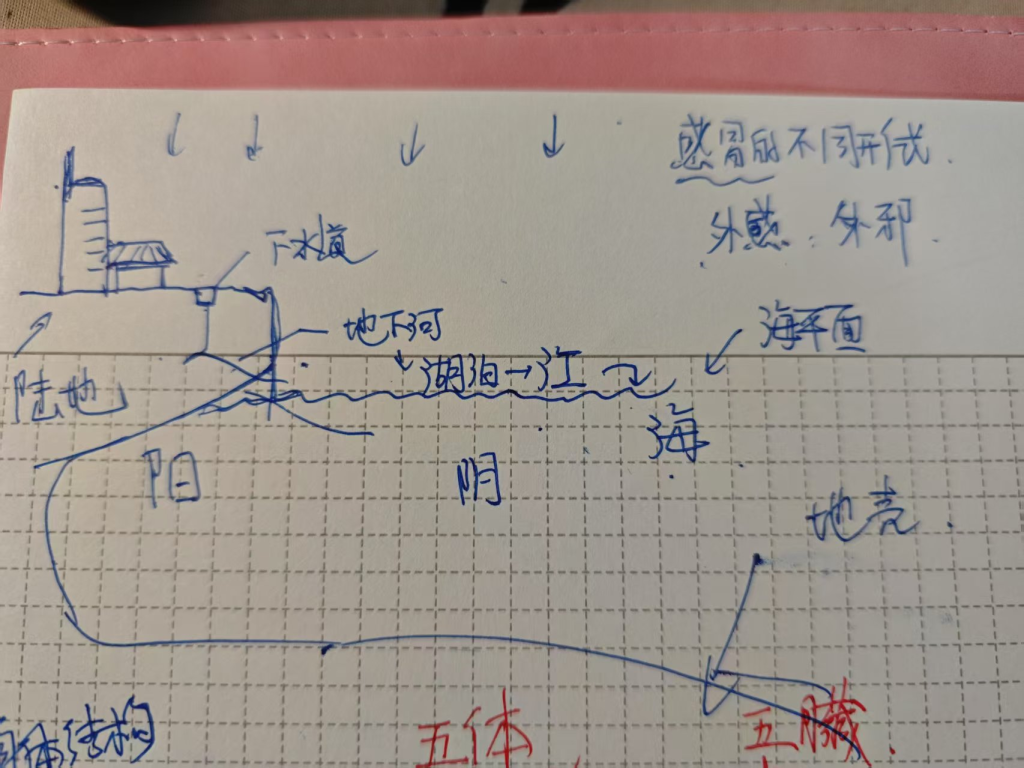
The land can be seen as yang, and the sea, or sea level, can be seen as yin.
III. Layered Diagnosis and Treatment Strategies
Our bodies are like the structure of land and sea.
The skin has pores, which is the first layer of defense.
The second layer is the flesh.
The third layer is the vessels.
The fourth layer is the tendons: for example, when eating chicken feet, the white, tough, and crispy membrane inside is the tendon, which is attached to the bone;
Then there are the bones.
This is the body structure described in TCM.
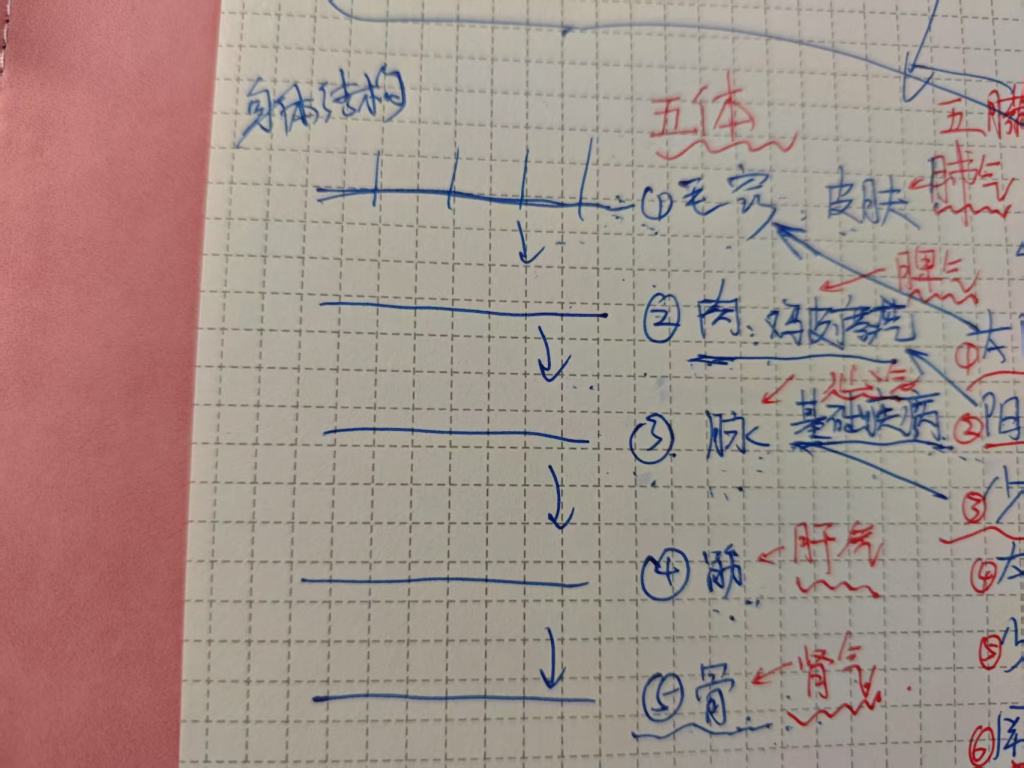
TCM divides the common cold into six layers: Taiyang, Yangming, Shaoyang, Taiyin, Shaoyin, and Jueyin.
Don’t get too caught up in these professional terms; think of them like understanding 1, 2, 3, 4, 5, 6.
For people with good health, when they catch a cold, the external pathogen only stays on the surface, which is the Taiyang layer, the shallowest layer. At this point, no treatment is needed; just exercise, drink some ginger and brown sugar water, or boil some scallion whites and light fermented soybeans to drink, and sweat it out, and you’ll be fine right away.
For some people with slightly weaker constitutions, the cold might break through the first layer of pores and reach the flesh, which is the Yangming layer. At this point, you’ll get goosebumps, so I often emphasize to moms and patients that getting goosebumps means you’ve caught a cold, and the cold has reached the second layer.
With COVID-19, many people experience body aches after infection; some have headaches, others have knee pain that wasn’t there before, and some develop lung nodules after getting COVID-19 or receiving the vaccine. This is because the pathogen has reached the third layer of vessels, corresponding to Shaoyang. When the pathogen reaches this layer, more body issues can arise, easily triggering underlying diseases.
TCM treatment for COVID-19 involves driving the pathogen back to where it came from, and the symptoms will disappear. For the damage already done, such as lung nodules, slow conditioning and recovery are needed. If the body is even weaker, with underlying diseases, like a back injury followed by a COVID-19 infection, the back pain will worsen. Because the body’s righteous qi is insufficient, the pathogen, like squeezing a soft persimmon, will expose deeper issues in the body.
Bones generally don’t have problems easily because the body is very intelligent and will first protect vital organs and tissues; bones are well-protected inside the body. However, leukemia is an exception; we know that leukemia patients need bone marrow transplants. By transplanting bone marrow, healthy hematopoietic stem cells are implanted into the patient’s body, and these healthy stem cells can “settle” in the patient’s bone marrow, proliferate, and differentiate into various normal blood cells, thereby rebuilding the patient’s normal hematopoietic and immune functions, fundamentally correcting the hematopoietic abnormalities caused by leukemia.
In modern medical concepts, it is believed that the marrow can govern hematopoietic ability. In fact, TCM clearly states that it is not the marrow that governs, but the kidneys. It is because the kidney qi is damaged that leukemia occurs.
Often, it’s because of a cold; initially treating the cold as inflammation, overusing anti-inflammatory drugs, leading to the pathogen penetrating deeper, and eventually, the condition becomes severe.
The general idea is that the pathogen penetrates layer by layer, breaking through our body’s defenses. How to handle it correctly requires some professional knowledge; take your time, everyone.
Our body structure, apart from skin, flesh, vessels, tendons, and bones, also includes the viscera.
The skin corresponds to the lungs, which govern the skin and hair;
The flesh corresponds to the spleen;
The vessels correspond to the heart, which governs the vessels;
The tendons correspond to the liver, which governs the tendons;
The bones correspond to the kidneys, which govern the bones.
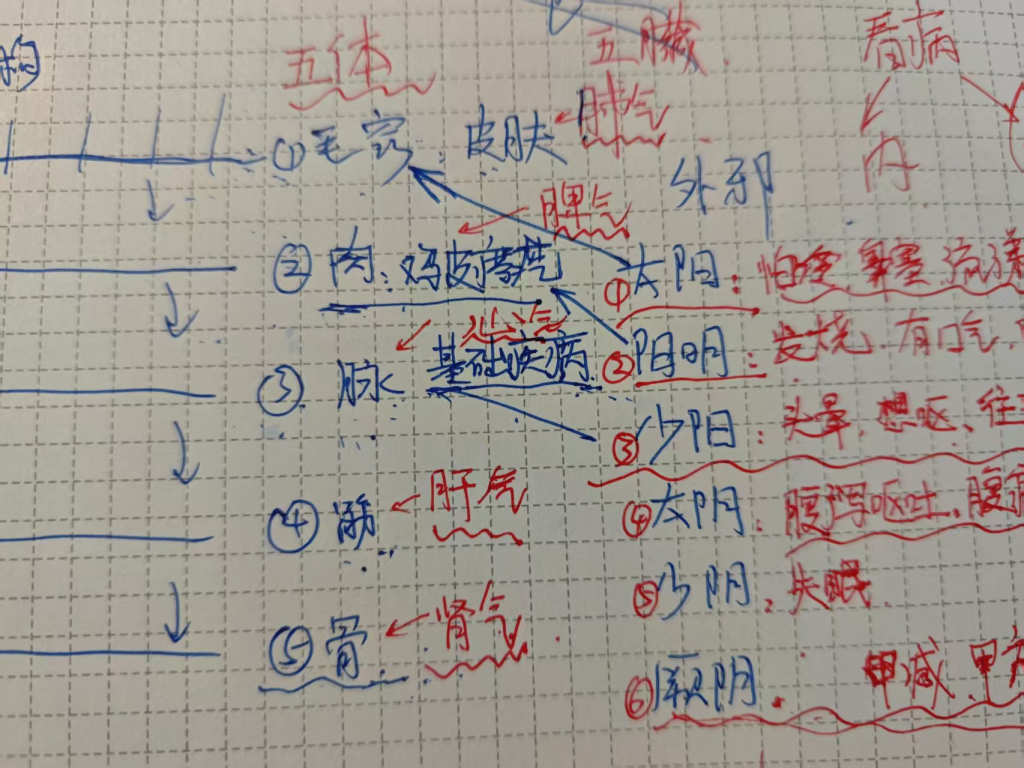
For example, when bones have problems, people often say to supplement calcium, but supplementing calcium is not the same as supplementing bones; although bones contain calcium as a main component, it is the kidney qi that maintains bone density and generates bones.
For instance, tendons; when we feel calf or lower back pain after climbing a mountain, it’s tendon pain, and the condition of the tendons depends on the liver.
Vessels are the channels for nutrient transport throughout the body, not just blood vessels and nerves; the body, like fish or pork, is layered, with gaps between the layers serving as channels for nutrient transport, and the vessels depend on the heart.
If a child is too thin and doesn’t gain weight, or too fat but the flesh isn’t firm, the spleen needs to be strengthened.
Skin problems, such as allergic skin diseases, urticaria, and enlarged pores, are all related to the lungs.
So, from these correspondences, some principles of disease treatment are already implied.
For example, to adjust a child’s constitution, you need to supplement from the inside out.
If the kidney qi is sufficient, there’s no need to supplement; if the liver qi is insufficient, start supplementing from the liver qi, and so on.
If the spleen and stomach are not good, focus on supplementing the spleen.
We can’t just look at local symptoms; we need to view diseases comprehensively and holistically.
Next, let’s talk about what everyone is most concerned about: how to determine which layer a cold has reached in yourself or your child.
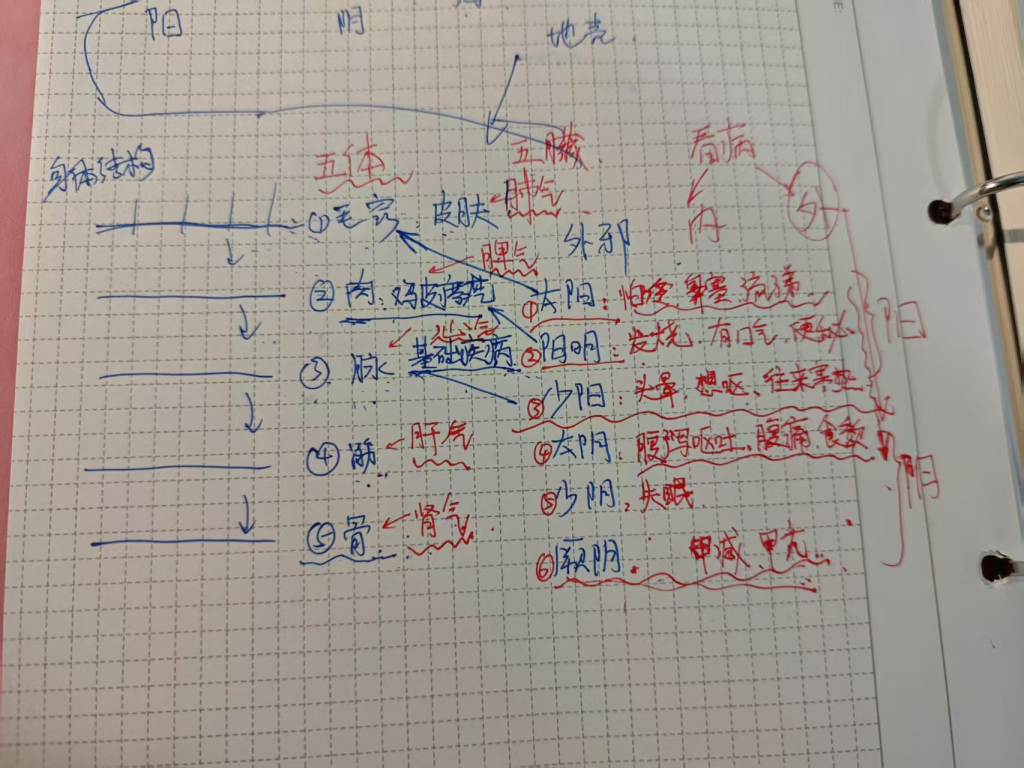
1. Taiyang Layer (Exterior Syndrome)
- Symptoms: A cold at the Taiyang layer often presents with symptoms like aversion to cold, nasal congestion, and a runny nose. Morning sneezing, coughing when exposed to cold, and itchy skin.
- Warning Against Mistreatment: Overuse of cold and cooling drugs (like Shuanghuanglian) can cause the pathogen to penetrate into the Yangming layer.
- External Treatment: Steaming the nasal passages with scallion white and fermented soybean soup, combined with moxibustion on the Dazhui acupoint.
2. Yangming Layer
The second layer, the Yangming layer, commonly presents with symptoms like fever, bad breath, and constipation; many children may have these symptoms.
3. Shaoyang Layer (Half-Exterior, Half-Interior)
- The third layer, the Shaoyang layer, has symptoms like dizziness, nausea, and alternating chills and fever. Alternating chills and fever means feeling cold and then hot; this is more noticeable in people approaching menopause.
If you suddenly feel dizzy and it’s not a frequent occurrence, it might be due to catching a cold; in this case, you can try taking Xiao Chai Hu granules first, and if it helps, you can save a lot on medical tests.
But if you frequently feel dizzy, it might not be due to catching a cold; it could be an internal body issue that needs slow conditioning. - Core Pathogenesis: Liver and gallbladder heat with spleen deficiency and dampness obstruction.
- Key Points for Medication: The dosage of Huang Qin in Xiao Chai Hu Tang needs to be adjusted according to the constitution (reduced for those with yin deficiency).
4. Taiyin Layer (Interior Deficiency and Cold Syndrome)
- Starting from the fourth layer, the Taiyin layer, it enters the yin aspect, which has a greater impact on the body.
For example, if you have a cough from a cold, and it only occurs during the day, morning, or before sleep, taking some over-the-counter Chinese medicine will do;
But if you wake up coughing in the middle of the night, it means the pathogen has penetrated deeply, and many over-the-counter Chinese medicines won’t solve the problem; you need to take medicine quickly and use Chinese herbal medicine for treatment.
Common symptoms of the Taiyin layer include diarrhea, vomiting, abdominal pain, and loss of appetite.
When a child vomits, you need to distinguish whether it’s from the Shaoyang or Taiyin layer; sometimes I might recommend patients take Xiao Chai Hu granules or Huoxiang Zhengqi pills (granules) depending on the situation.
If it’s cold and dampness reaching the Taiyin layer, Huoxiang Zhengqi pills can solve a significant part of the problem.
When taking it, you can follow the instructions and take it twice a day, or you can take it three times consecutively in a day, with a five to ten-minute interval between doses, and the effect will be very noticeable.
But if it doesn’t solve the problem after taking it, you need to go to the hospital quickly.
The reason why Taiyin layer issues are relatively common is that many children have poor eating habits, liking to drink cold or icy drinks, eating indigestible foods, leading to spleen and stomach weakness, and they easily get abdominal pain and vomit when they catch a cold. - Dietary Therapy: Ginger and yam porridge (10g ginger + 50g yam + japonica rice) to warm and supplement spleen yang.
- Contraindications: Avoid drinking cold beverages on an empty stomach and excessive intake of high-fiber foods.
5. Shaoyin Layer
Issues at the Shaoyin layer are related to sleep, such as insomnia.
If you get insomnia after catching a cold, it indicates insufficient liver and kidney energy.
Of course, this type of insomnia isn’t about not being able to sleep at night after catching a cold; it’s about feeling a decline in sleep quality, not sleeping deeply, and waking up easily.
This kind of insomnia caused by catching a cold can’t be treated with suitable over-the-counter Chinese medicine; you need a prescription for treatment.
6. Jueyin Layer (Mixed Cold and Heat)
- The last layer, the Jueyin layer, has symptoms similar to hypothyroidism and hyperthyroidism.
Some mothers have experienced hyperthyroidism, with obvious symptoms at the time, such as palpitations, trembling hands, sweating, insomnia, and appetite issues, either not wanting to eat or feeling very hungry, various discomforts, mixed cold and heat, upper heat and lower cold, and changes in appearance, with the face becoming thinner and the eyes appearing more prominent.
Western medicine generally considers issues at this layer to be related to the immune system, requiring lifelong medication, but TCM has ways to condition it, supplementing from the inside out, slowly driving the pathogen out. - Special Therapy: Applying vinegar-soaked Wu Zhu Yu to the Yongquan acupoint to guide fire back to its origin, combined with modified Wu Mei Wan.
IV. Clinical Misdiagnosis and Correction Guide
- Misconception 1: Mistaking Shaoyang dizziness for insufficient cerebral blood supply
- Differentiation Point: Shaoyang dizziness is accompanied by a bitter taste in the mouth and sensitivity to light; insufficient cerebral blood supply is often accompanied by limb numbness.
- Misconception 2: Overuse of antidiarrheal drugs for Taiyin diarrhea
- Correct Handling: Huoxiang Zhengqi pills should be combined with hot compresses on the Shenque acupoint, and cold foods should be avoided for 48 hours.
- I covered a lot of content today. Here are a few key points to remember:
1. Be aware that various discomforts in the body might be due to a cold; don’t over-treat or misuse anti-inflammatory drugs.
2. If your constitution is not weak and it’s just an external pathogen invasion, driving the pathogen out will help you recover quickly.
So, we need to focus on conditioning our constitution to prevent the pathogen from invading the body.
V. Constitution Conditioning and Prevention
Mother’s Question:
- The child used to have frequent tonsillitis and colds with fever; after conditioning, tonsillitis has decreased, but the skin has started to itch, and it hasn’t been resolved after several attempts at conditioning. Is it because the heat has moved from the inside to the skin layer?
TCM Doctor’s Answer: Actually, this is the pathogen retreating from the second layer to the first layer, but because the internal constitution hasn’t been solidified yet, the pathogen is still lingering at the first layer. In this case, continue using herbal plasters for conditioning; don’t keep changing the prescription, but provide regular feedback because catching a cold or eating the wrong food during the process can affect the body’s recovery. Many children are afraid of heat, and from a TCM perspective, there are reasons for this. Being afraid of heat might be due to yin deficiency or excessive damp heat.
VI. Modern Research Evidence
- Pharmacological Research: Chaihu saponin D can downregulate IL-6 expression, improving fever in Shaoyang syndrome.
- Imaging Evidence: Biopsies of nasal mucosa in patients with chronic sinusitis show significant goblet cell hyperplasia in the wind-cold syndrome group.
Note: Today, I not only discussed different forms of the common cold but also talked about constitution and the principles of many diseases. The therapies mentioned in this article require diagnosis by a TCM practitioner; for acute, critical, or severe conditions, seek medical attention promptly. The transmission of the common cold varies individually and requires comprehensive judgment based on pulse and tongue diagnosis.
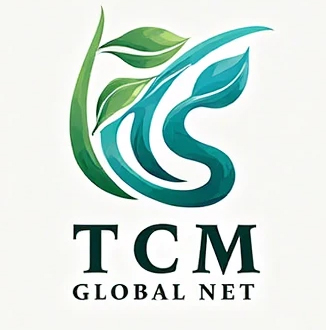
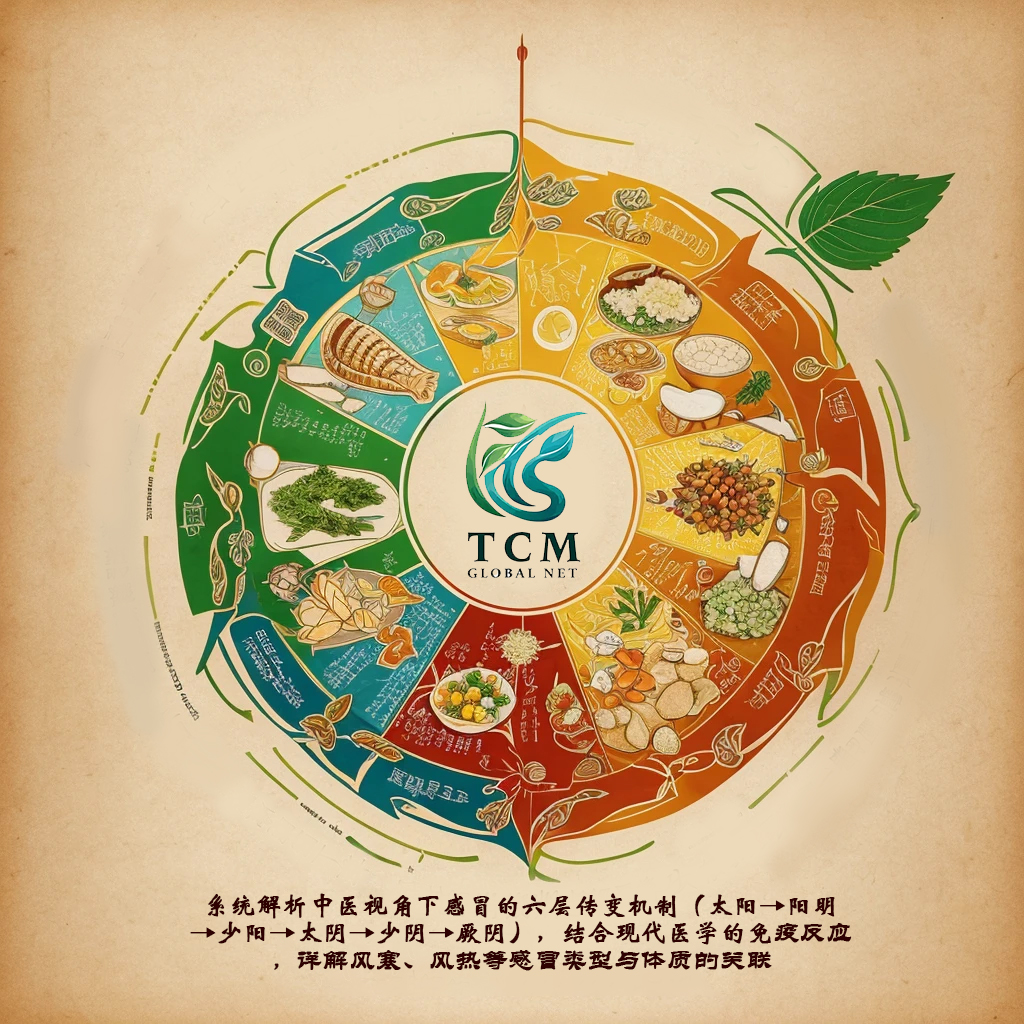
Leave a Reply